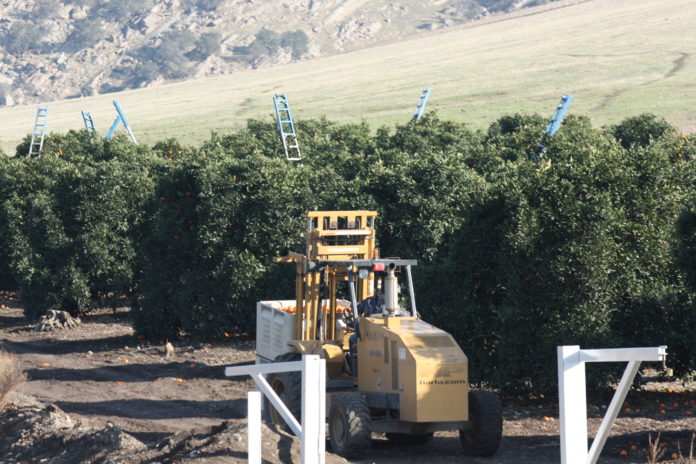The Tulare Irrigation District held its board of directors meeting on Tuesday, April 11, 2023 at its headquarters west of Tulare and online with Zoom. There will be a congressional hearing later in the day, 2:00pm at the International Ag Center in Tulare, more commonly known as the World Ag Expo grounds. Congressman David Valadao will be joined by many of the same representatives who conducted the Farm Bill hearing on the first day of the Ag Expo. Valadao has a bill HR 215, “Water for California” that will:
- Extend authorization of the successful surface water storage project program established by the WIIN Act
- Streamline operations by requiring the Central Valley Project and State Water Project be operated consistent with the 2019 Biological Opinions, and
- Increase water storage infrastructure by making additional funding available for the Shasta Dam and Reservoir Enlargement project, the most cost-effective water storage project in California.
Another bill, HR 872 “The Fish Act” will end the burdensome bifurcation of federal salmon regulations under the Departments of Commerce and Interior. The Fish Act will move all things salmon to the Interior Department. A good, common sense idea which under this administration puts a target on its back.
The Meeting
Chairman David Bixler called the meeting to order at the scheduled 9:00am start with there was no public comment. The minutes were approved, I believe with one correction.
Water Report
Water Master Marco Crenshaw reported since they met last month there were some warm rainstorms that washed much of the lower elevation snow causing record inflow at Lake Kaweah and some flooding. Director Dave Martin asked how long will that record last? June? They are releasing a lot of water to make room for further snow melt.
General Manager/Philosopher Aaron Fukuda said one of the men in charge of levee protection during this time went to work for 36-hours immediately after undergoing chemotherapy. Wow. I’m sorry I didn’t catch his name. We grow them tough here in the Valley.
Crenshaw said the current warm weather is actually helpful because it softens up the snowpack and then it freezes during the night. This helps preserve the supplies because snow melts faster than ice. That’s not to say if we hit a hot spell things won’t come undone. However, the projected forecast looks favorable for the time being. We may have another storm towards the end of the month. Hopefully not a warm rain event. It seems that warm rain (and it wouldn’t feel warm to us but we’re not snow) puts the melting process into overdrive. The big flood in the 1860s that put the entire Central Valley underwater was a result of a big snowpack followed by warm rains. There’s no historical record indicating anyone blamed it on climate change.
On the San Joaquin River inflow is greatly exceeding demand. There is so much water coming down in local streams there is very little room for moving it down the Friant Kern Canal. Fukuda said this is a win/win for the Red Top area where folks along the By Pass are able to take a big slug of water for much needed recharge in the area.
Fukuda put up a slide showing the extent of the flooding in the Tulare Lake Basin. It’s big. He then put up a slide showing the extent of the 1983 floods. There is a prominent levee that split the lake bed east and west. But subsidence has changed the grading of the area.
Fukuda said Shasta is close to filling and Friant allocations are 100 percent Class I and 79 percent Class II. Class I is the first 800,000 a/f available delivered. Then the Class II supplies begin. Millerton Lake only holds 500,000 a/f and the San Joaquin River’s annual average yield is 1.5 – 2 million a/f. That means Millerton Lake is typically filled and drained four times per year equivocally. This year could double that turnover easily. The Kings River is a mirror of the San Joaquin River watershed, but Pine Flat Lake holds more than one million acre feet.
Somewhere in all of this Crenshaw noted the Blob, a patch of warm water in the Pacific Ocean is still there, so he’s discounting it when preparing his projections. He should go with pig spleens. Remarkably accurate predictors of the weather.
Water Rates
Fukuda said at the height of the recent runoff there was 10,000-11,000 cfs flows down the channels TID depends on. If I understood the Army Corps of Engineers only rates these channels at 6,000 cfs capacity. TID and Lower Tule River ID have set a groundwater credit of 75 percent to growers and 25 percent to the districts. This water was free and accurate monitoring wasn’t possible under the conditions. He said now that the reservoir is under control and the channel capacity emergency is over he’s asking the board to return to $52 per a/f for groundwater credit. This is intended as an incentive to continue as much recharge as possible. Martin said even though there is a massive amount of water available and surely some growers will complain it is still a much better way for the district to finance itself than having to raise the assessments. Everyone agreed with that. Fukuda said the figures can be reevaluated later this year.
Director Rick Borges suggested it might be better to charge less, like $42 per a/f now and if necessary raise the rate higher later. He said the district will be selling water in July and August and can make up the difference then. He said if the floods hit later this spring/early summer it would be best to not lower the prices then. There was a lengthy conversation and consultant James Fisher was asked about how the credits could be allocated. Eventually the board agreed to the $42 price starting Monday, April 17th.
O&M Report
Next Superintendent Wayne Fox said the high flows have caused erosion problems and the Kaweah Delta Water Conservation District has helped with dump trucks to haul material. In turn TID helped Kaweah Delta to keep some trash screens clear. There were some gates that needed repair and Fox said everyone was very busy. He said even Crenshaw was helping out in the shop. It takes seven ditch tenders for daytime and two overnight. In total he needs a crew of 14 but hasn’t had more than a dozen so far this year. But the district is hiring, or has hired – not sure, and will be back at full force soon. Fox also reported due to windier than normal conditions weed spraying is a bit behind schedule but they are catching up.
Financial Reports
Controller Kathi Artis gave her reports about TID’s accounts and how the money has been moving here and there. The board was comfortable with her explanations and agreed to pay its bills. I stepped away from my desk for a moment and when I came back the board was asking Fukuda what specifically was discussed at the donut factory meeting in regards to GSP finances. I believe it was Borges who remarked the results were full of holes. Somethings we’ll never really know for sure. Fukuda did say there is a space of time wherein the grant income lags behind the obligations to pay. I guess that’s like a Medicare prescription donut hole. There was also a discussion on the 2006 Ford F-150s not having enough bolts to keep the head in place and they are always having to work on them. The district’s spray rig is an F-150 if I understood.
Engineering Report
Engineer, or rather former district engineer Jeremy Barroll has moved on from TID. So, for the time being Fukuda has had to stretch his engineering wings again. He spoke about a developer and the City of Tulare coming into agreement over title to a parcel underlying a canal. Fukuda said he consulted with attorney Alex Peltzer about TID taking title and Peltzer said do it. He said this is the best position for TID for whatever could come along. Fukuda also said the developer and the city have been very cooperative.
Management & Staff Reports
Under SGMA Fukuda said the Kaweah Subbasin was tag teaming between Provost & Pritchard but now the Mid Kaweah GSA has Montgomery & Associates, East Kaweah GSA has P&P and a new one – Intera and the Greater Kaweah GSA is working with Thomas Harder and Four Creeks. All of this to deal with addressing DWR’s comments on the subbasin’s GSP. Fukuda said Harder and Intera are working hard to catch up. There will be a meeting with the State Board early next month to try and present the subbasin’s schedule to fix the GSP.
Progress is being made on the data management system. The modeling is being addressed by the teams and they asked for management to stay out of the room so they don’t muck things up.
Fukuda said the MKGSA has approved invoice appeals and revised invoices have been sent out. He said the system and procedure is being refined and he sees things falling into place. He said the GSA is operating under emergency orders and it is time to move to rules and regulations. These can be fine-tuned and put into place as policy.
Fukuda said Bermad meters proved to be the most accurate but no one knows where to find them. There was also a great deal of problems due to gophers with underground irrigation on hay.
FWA Report
It was reported by Borges the Friant Water Authority granted employees a 3.3 percent COLA increase. The amount of change orders on the Friant Kern Canal repairs was only about two percent of the budget, a big improvement from industry standards. Then Deer Creek flooded. We’ll see what happens. Alex Biering has left the FWA for the California Farm Bureau and she’s a great asset for the Farm Bureau and loss to Friant. However, she’s still available and in touch.
There was also discussion about pumping Warren Act water cost recovery. It costs $11.60 a/f fee and the talk is to charge non-Friant contractors $25.07. Boswell and Renewable Resource Group would feel the biggest impact. Friant contractors would have their Warren Act costs included in their 25-year average. Fresno ID, Lindsay Strathmore ID and Lindmore ID are the big players on this side of the coin. There will be a 60-day comment period.
Resource Group would feel the biggest impact. Friant contractors would have their Warren Act costs included in their 25-year average. Fresno ID, Lindsay Strathmore ID and Lindmore ID are the big players on this side of the coin. There will be a 60-day comment period.
Fukuda told the board Congressmen Valadao and Jim Costa are working to get funding for a feasibility study on the McKay Point/Seaborn Reservoir. Getting this money would unlock further USBR funding.
Legislation
Fukuda said the amount of legislation at Sacramento dealing with water is mind numbing. He said some of it is very impactful and TID needs to start weighing in. There are three bills ceding the State Board new power and authority. This is a direct challenge to water rights. The State Board members and staff change. Government in Sacramento will continue to try to expand its power. Fukuda said no one has better managerial expertise than the locals. Assemblyman Steve Bennett of Ventura was pointed out as particularly myopic in his one size fits all approach to writing laws. There is one bill, AB 30 that will be helpful in forecasting weather and snowpack. The board approved staff recommendations and will petition ACWA to pass it along.
continue to try to expand its power. Fukuda said no one has better managerial expertise than the locals. Assemblyman Steve Bennett of Ventura was pointed out as particularly myopic in his one size fits all approach to writing laws. There is one bill, AB 30 that will be helpful in forecasting weather and snowpack. The board approved staff recommendations and will petition ACWA to pass it along.
Fukuda also reported on his recent experience at the Future of Ag Summit at Fresno State University. He was on an irrigation panel with two irrigation manufacturers and had to remind folks flood irrigation is one path to sustainability. I also attended that summit and was surprised to see a panel discuss how growers should fallow/repurpose their land. Not one farmer was on the panel. It was all academia and NGOs. One representative was with the Union of Concerned Scientists. The Los Angeles Times released a story about a Union of Concerned Scientists report stating California’s transgendered people are some of the most worried about climate change impacting their drinking water. I’m waiting to attend a summit on the future of higher education and non-governmental organizations and see a panel of the Union of Concerned Farmers.
academia and NGOs. One representative was with the Union of Concerned Scientists. The Los Angeles Times released a story about a Union of Concerned Scientists report stating California’s transgendered people are some of the most worried about climate change impacting their drinking water. I’m waiting to attend a summit on the future of higher education and non-governmental organizations and see a panel of the Union of Concerned Farmers.
He also attended a Collaborative Action Plan meeting at Santa Nella and he said someone has pumped a gob of money into the facilities at the Mission de Oro Hotel. He said it looks like Harris Ranch Inn north. He said there was a tour of the Red Top area and he gave Sarah Woolf and Chase Hurley great kudos for the work they are doing. He said the tour of Del Puerto included Fukuda being singled out as a Friant guy when it was mentioned the Sierra Club and some Friant contractors are suing. He also said he’ll be testifying at today’s hearing. Director Martin asked Fukuda if there will be an investigation in the documents he has at his house.
Sierra Club and some Friant contractors are suing. He also said he’ll be testifying at today’s hearing. Director Martin asked Fukuda if there will be an investigation in the documents he has at his house.
Board Action & Reports
Next Fukuda told the board TID’s share of a study by Stantec regarding bringing back the FKC to full capacity will be about $400,000. He said he’s opposed to a study for the sake of a study only to find out they can’t afford to do anything. However, he said this will include more information on increased off stream storage along the FKC, which would be more affordable and potentially of great benefit to TID. The board agreed to an MOU.
The board then approved a resolution honoring Roy Bell’s retirement. Bell has some health concerns and it sounded like his leaving is going to be challenging to the district. TID has some slots to fill.
Directors Reports & Closed Session
The directors also serve as representatives to other entities. Martin is on the MKGSA and I thought he said Dan Vink will be the new Kaweah Water Master but turns out he said Vic Hernandez who works for the Kaweah Delta Water Conservation District. Vink is the former GM at Lower Tule River ID and Pixley ID. Totally different watershed.
Borges said he met at the Kaweah Basin Water Quality Association and there will be more advisory committee meetings.
Mike Thomas reported on some meeting but it went really fast and I didn’t catch it.
At 11:44am closed session started. The agenda listed four lawsuits and some personnel matters. So that was that at TID this month. Stay safe, healthy and as happy as possible.
DISCLAIMER OF RESPONSIBILITY; Waterwrights strives to provide clients with the most complete, up-to-date, and accurate information available. Nevertheless, Waterwrights does not serve as a guarantor of the accuracy or completeness of the information provided, and specifically disclaims any and all responsibility for information that is not accurate, up-to-date, or complete. Waterwrights’ clients therefore rely on the accuracy, completeness and timeliness of information from Waterwrights entirely at their own risk. The opinions expressed in this report are those of the author and do not represent any advertisers or third parties.
ALL RIGHTS RESERVED. Copyright 2023 by WaterWrights.net/DAW
TULARE IRRIGATION DISTRICT
6826 Ave 240, Tulare, CA 93274 Office: 559/686-3425
Board: David G. Bixler- President, Richard S. Borges, Jr.-Vice President, Scott Rogers, Dave Martin & Michael Thomas
Staff: Aaron Fukuda-General Manager, Jeremy Barroll-Engineer, Kathi Artis–District Controller, Wayne Fox–Superintendent, Marco Crenshaw–District Watermaster & Alex Peltzer-Attorney.
About: The Tulare Irrigation District was organized September 21, 1889. The original proposal for the formation of an irrigation district covering 219,000 acres, extending from the Sierra Nevada foothills to Tulare Lake, was eventually reduced to 32,500 acres. The District continued in this status until January of 1948 when the so-called Kaweah Lands” (approximately 11,000 acres) were annexed. In October of 1948, approximately 31,000 acres, compromising the area served by the Packwood Canal Company were annexed to the District. A U.S. Bureau of Reclamation contract was signed in 1950 providing an annual supply of 30,000 acre-feet of Class 1 water, and up to 141,000 acre-feet of Class 2 water from the Friant-Kern Canal. The District and the Kaweah Delta Water Conservation District have coordinated efforts to enhance the recharge of groundwater within the Kaweah Basin. During high flow times KDWCD may use the recharge basins with the District for recharge purposes. Further, KDWCD has historically provided for a financial incentive program through which the District sustains the level of groundwater recharge from supply sources into the District. This historical program was recently reinstated by both districts in lieu of the District’s plans to concrete-line this canal to conserve the surface water. TID is a member of the Mid Kaweah GSA DWR#-5-022.11































